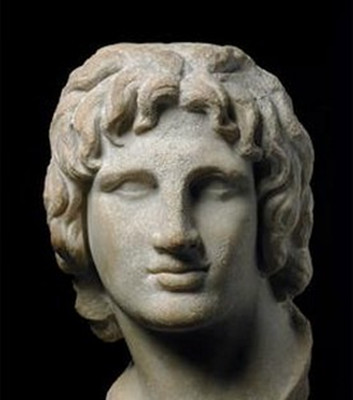What I'm looking at is the profile of a young man-his straight nose and his strong jaw line show classical good looks and strength, and he's looking keenly into the distance-the tilt of the head commanding and suggestive of vigorous forward movement.
上面铸有年轻男子的头像,鼻子与下巴的线条笔直,表现出古典美与力量。他凝视远方,前倾的头部流露威严,似乎要奋力向前。
We've got no way of knowing whether this is an accurate likeness of Alexander but it must be him, because as well as human hair this man has ram's horns.
我们无法了解这个头像是否反映了他的真实相貌,但我们十分肯定他的身份,因为银币上的人除了人类的头发之外,还有一对公羊角。
It's the horn symbol, well-known throughout the ancient world, that leaves the viewer in no doubt that we're looking at an image of Alexander the Great.
公羊角的象征意义在古代社会尽人皆知,毫无疑问,这就是亚历山大。
The horns are associated with the god Zeus-Amon-a hybrid of the two leading Greek and Egyptian gods, Zeus and Amon.
公羊角所代表的宙斯-阿蒙神是希腊与埃及两位最重要神祇的结合体。
So this small coin is making two big statements-it asserts Alexander's dominion over both Greeks and Egyptians, and it suggests that, in some sense, he is both man and god.
因此,这枚小小的银币具有双重含义:其一,亚历山大统治着希腊与埃及,其次,他既是凡人,也是神。
Alexander the man was the son of Philip II of Macedon, a small kingdom a few hundred miles north of Athens.
作为人的亚历山大是马其顿国王腓力二世之子。马其顿是个位于雅典以北数百英里的小国。
Philip expected great things of his son and he employed the great philosopher Aristotle as Alexander's tutor.
腓力二世对儿子寄予厚望,聘请了著名的哲学家亚里士多德来教导他。
Alexander came to the throne in 336 BC at the age of 20, with an almost limitless sense of self-belief.
公元前三三二年,二十岁的亚历山大登上王位, 自信满满,
His goal was to reach the "ends of the world and the Great Outer sea", and to do this he embarked on a series of wars, crushing rebellions by Athens and the other Greek cities, and then turning east to confront the long-standing enemy of the Greeks-Persia.
声称自己将到达“陆地与海洋的尽头”。为完成这一宏愿,他发动了一系列战争,首先平息了雅典与其他希腊城市的反叛,然后挥师向东,讨伐希腊的宿敌波斯。
Persia was at that point the greatest empire on earth, sprawling from Egypt across the Middle East and central Asia to India and almost to China.
波斯是当时世界上最伟大的帝国,领土囊括埃及、中东、中亚,直达印度,几乎与中国接壤。













